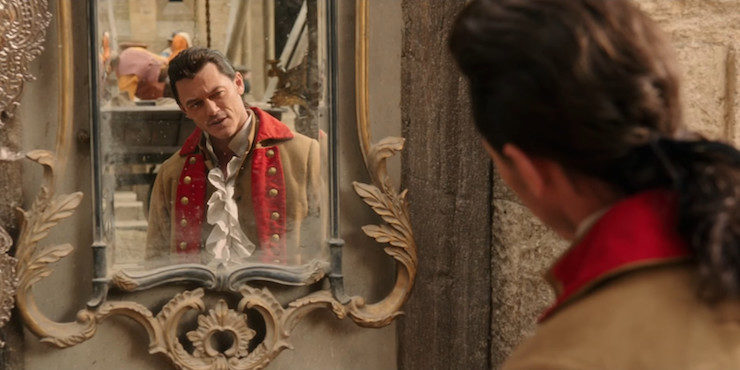Beauty and the Beast is one of the biggest jewels in Disney’s animated crown, full of memorable songs, gorgeous imagery, and a lovely yet simple tale as old as time. (What, I had to. You’ll have to catch me to stop me.) It also has the distinction of being the first animated film ever nominated for the Academy Award for Best Picture. So the question is: aside from making oodles of cash, what could this live action reimagining bring to the table?
Because it does bring a few new concepts to the mix… but likely not in the way anyone expected.
The main selling point of this remake was clearly casting Emma Watson as Belle. This little bit of casting magic was every project’s dream, and she is lovely, especially at points where she manages to offer additional warmth (plus some much needed romance injected into the love story), but there are areas where she seems to have been directed oddly. There is a strange roteness to the character, with Watson often reacting to cues before the previous line has landed. It’s a shame because she is entirely charming otherwise.
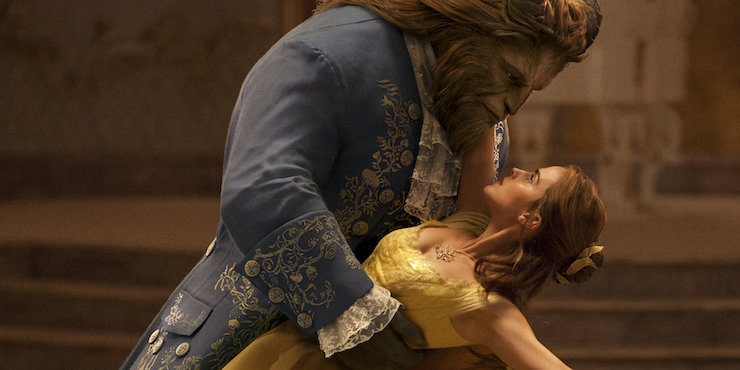
While director Bill Condon has plenty of musical directing experience to recommend him, 3D seems to have been his nemesis. The entire film is chock full of sweeping spin shots that look like nothing but blur in 2D, rendering the film completely unwatchable in many of its most emotional moments. The CGI characters are well rendered and articulated at the very least, but they do lack much of the expression offered to their less realistic animated counterparts, which is sometimes awkward in places like the musical numbers.
In terms of music, the person who disappoints the most is sadly Watson, who is clearly and extensively autotuned throughout. While it’s understandable that Disney could not bear to pass up the Hermione=Belle connection, it is getting tiresome to watch films continually promote actors with little inclination toward singing as though their lack of know-how is supposed to be charming. (Hey there, La La Land.) Even Emma Thompson, titan of stage and screen, simply cannot touch Angela Lansbury’s iconic rendition of the title song, which would have been fine had the film seemed interested in compensating for the change—the visuals are lovely, but the song is affecting primarily due to nostalgia. Ewan McGregor has a much easier time approaching Jerry Orbach’s dazzling “Be Our Guest,” though that is undoubtedly because this is not his first melodic rodeo; he does the part of Lumiere justice, and his endearing repartee with Ian McKellen’s Cogsworth only helps the film along. Of course, it’s Broadway staple Audra McDonald who steals the show every time she’s on screen as the wardrobe/palace chanteuse, so much so that it is she who picks up the title song to close out the film.
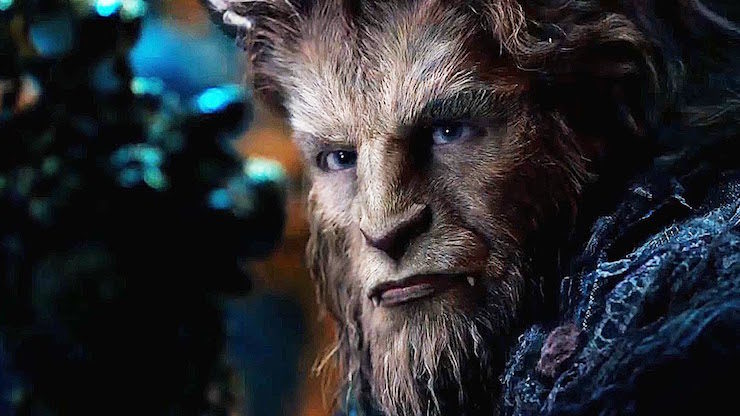
Dan Stevens has the difficult job of bringing the Beast to life even through layers of computer generation, and he handles the part with striking sensitivity, imbuing the hidden prince with a needed sense of youth and inexperience. His difficulty expressing himself and enjoyment at seeing the world anew through Belle makes their connection all the more convincing, and he’s endearing in every way that matters. (On the other hand, when you encounter the owner of the bookshop in Belle’s town this time around, you might find yourself wondering why she didn’t just run off with that guy.) The build of Belle and the Beast’s relationship is less rushed, and the movie makes a better case for what the two characters have in common, and what their future together might actually look like.
The opening third of the film drags, too married to the original Disney plot to do anything all that interesting. (That is, other than the immediate opening, where they wisely opted out of replicating the stained glass window sequence, and instead decided to focus on expanding the Beast’s backstory.) There was quite a happy kerfuffle over fixing one of the animated films’s most glaring potholes—the fact that the timeline indicates that the young prince was cursed by the Enchantress when he was only about ten years old if the years given by Lumiere are to be believed—but the result actually leaves more questions in its wake. While the new film does not give specific spans of time, there is an odd addition regarding Belle’s village that makes one wonder if the entire story takes place in some sort of time bubble. It’s a strange misstep while attempting to fix another.
There was another kerfuffle over Bill Condon’s mention that Le Fou (Josh Gad) would have an “explicitly gay” moment in the film, which incited anger from homophobic fringes, and ire from LGBT fans who were aggravated that Disney might be expecting inclusivity cookies for including a queer character who is likely in love with the film’s antagonist. But the moment was fleeting as you please, and also did not involve the antagonist is question. There is instead another character who has a little coming out moment at the end of the film, and while his encounter with Le Fou is cute, it’s certainly not of any import overall. (We could perhaps argue that Cogsworth is also meant to be gay, given the unfortunate reaction he gives to another female character at the end of the film, but that’s another matter entirely.)
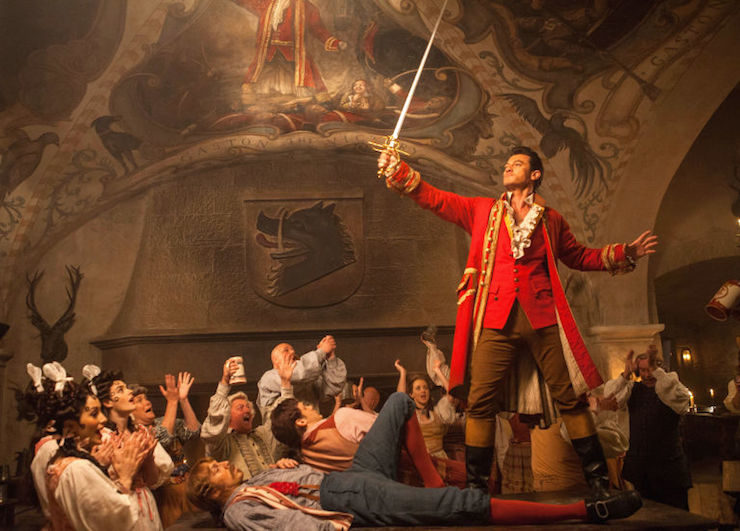
For all these recreations and alterations, the person who stands apart is surprisingly one of Disney’s most odious villains. Luke Evans gives a fantastic turn as Gaston, but it isn’t merely his performance that stands out—it is that manner in which the script addresses Gaston’s toxic masculinity with far defter strokes that its predecessor. Gaston isn’t just some big burly alpha male who gets what he wants with the application of muscle and bullheadedness; the film reveals this construction to be a lie, and instead chooses to focus on how men like Gaston truly operate in the world. We learn that Gaston gets what he wants through deceit and bad temper, by threatening and manipulating others when the world doesn’t seem to go his way. What’s more, the story shows how the man is quick to turn on those who refuse his lead, and that crossing him is dangerous because he has a keen eye toward revenge. Certainty of his own privilege is what continually endangers good people, Belle and her father included, as well as a childlike inability to handle receiving less than exactly what he wants. The original version of the character didn’t come off quite so frightening because there was an aspect of dim-wittedness to him—but this Gaston is conniving and vicious, a true coward to the core, and the story is more interesting because of it.
Another aspect to this alteration is the presence of the Enchantress, who appears throughout the entire story this time, rather than a simple tip-of-the-hat at the start. While her addition offers pointed and constant commentary on “forgotten women” (i.e. hags, widows, witches, and any other woman deemed useless or threatening to society by living outside the standard labels of mother and wife), she is sadly silent throughout the film. While she is intended partly as a construct in service of the story, her actions by the end really do require more explanation and consideration. She is a fascinating addition, but doesn’t seemed to have been considered beyond her role at the periphery of things, which weakens the overall restructuring of the tale.
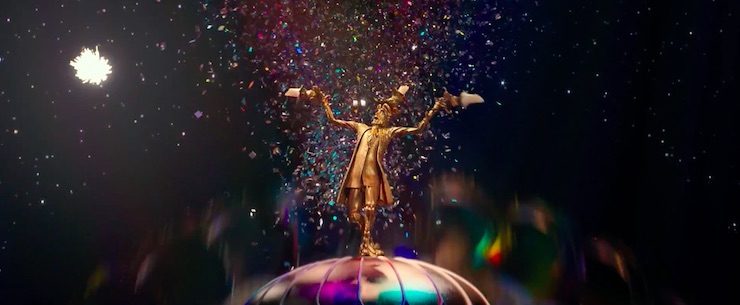
While there is no real need to retell one of Disney’s best animated features, this version was intriguing enough to warrant the visit. It does nothing to overtake the original, but at least there were a few points of variation and interest along the way, featuring cast that it’s hard not to love.
Emmet Asher-Perrin had most of her emotions about the wardrobe and the harpsichord, honestly. She did love Belle asking the prince to maybe grow a beard, too. You can bug her on Twitter and Tumblr, and read more of her work here and elsewhere.










